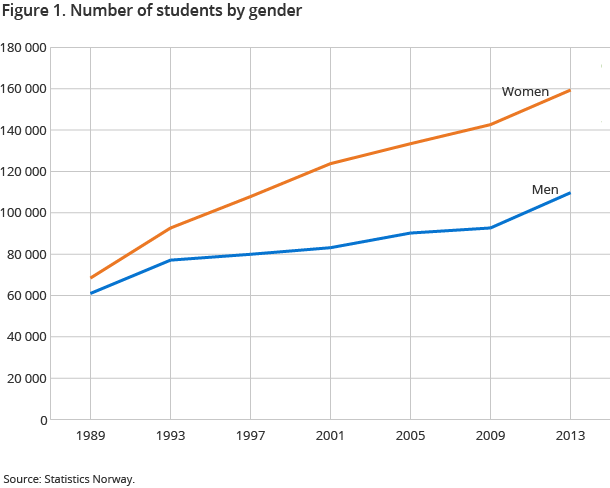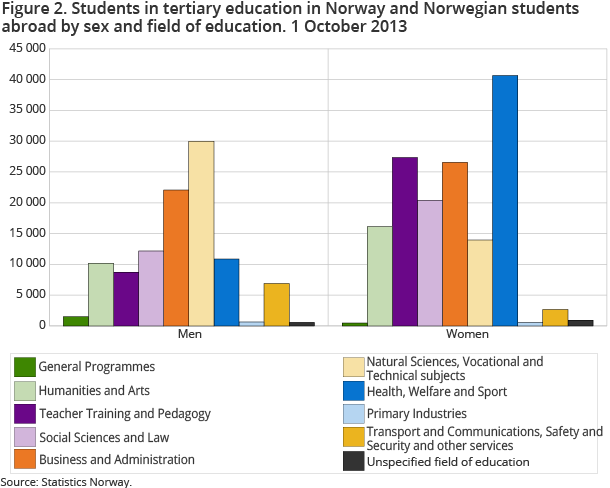Content
Published:
This is an archived release.
Most students in Health, welfare and sport
More than 20 per cent of all students were registered in Health, welfare and sport in autumn 2013. About 77 per cent of these were women. Of the total student population, 59 per cent were women and 41 per cent were men.
| 2013 | 2012 | 2003 | |
|---|---|---|---|
| 1Number of students at accredited web-based schools are missing for 2013. | |||
| Students in tertiary education1 | |||
| Total | 269 063 | 261 164 | 223 904 |
| Males | 109 700 | 104 459 | 90 416 |
| Females | 159 363 | 156 705 | 133 488 |
| Proportion 19-24 years in tertiary education | |||
| Total | 33.7 | 32.4 | 30.3 |
| Males | 27.5 | 26.1 | 24.7 |
| Females | 40.1 | 39.1 | 36.2 |
| Proportion 25-29 years in tertiary education | |||
| Total | 15.0 | 15.1 | 16.5 |
| Males | 13.3 | 13.2 | 15.3 |
| Females | 16.8 | 17.2 | 17.6 |


A total of 269 000 students in Norway and Norwegian students abroad were registered in tertiary education in 2013; about 45 000 more than in 2003.
The majority of students registered on teaching training programmes are female, with a proportion of 76 per cent. Courses of study on the primary industries had the smallest gender gap, with 51 per cent male and 49 per cent female students, while Natural sciences, vocational and technical subjects has the largest majority of male students; 68 per cent.
Pharmacy popular with immigrant students
Thirty-three per cent of the Master of Pharmacy students were immigrants in autumn 2013, while 19 per cent were Norwegian-born to immigrant parents. Master of Odontology was also popular among these groups, with 12 and 11 per cent respectively. Enrolment of immigrants and Norwegian-born to immigrant parents is still low for general teacher training programmes.
Larger proportion whose parents have primary education
In 1995, the proportion of students aged 19-24 whose parents had primary education as their highest educational attainment level was nearly 9 per cent. This proportion rose to more than 16 per cent in 2013. At the same time, the proportion whose parents had upper secondary education increased by 6 percentage points and the proportion for those whose parents had short tertiary education rose by 3 percentage points. There were very few changes in the proportion of students whose parents had long tertiary education.
Norwegian students abroad
Approximately 15 700 Norwegians were studying at tertiary institutions abroad in autumn 2013. The UK, Denmark, USA and Poland are the most popular study locations. Ten years ago, Australia followed by the UK, Denmark and USA were the most popular. Health, welfare and sport was also the most popular field of education among Norwegian students abroad.
Contact
-
Geir Nygård
E-mail: geir.nygard@ssb.no
tel.: (+47) 48 15 13 44
-
Maj-Lisa Lervåg
E-mail: maj-lisa.lervag@ssb.no
tel.: (+47) 45 68 84 72
